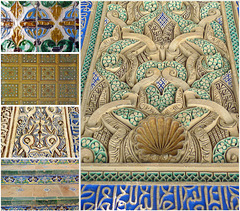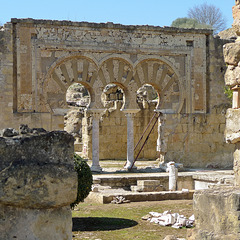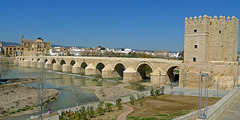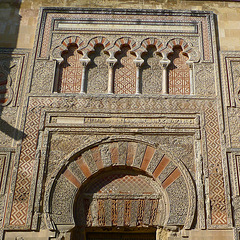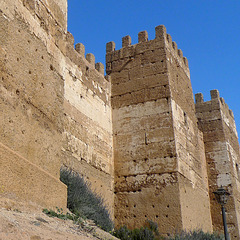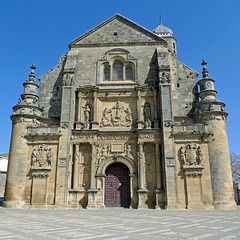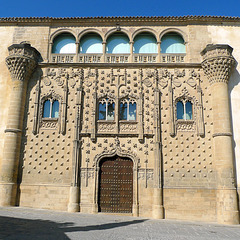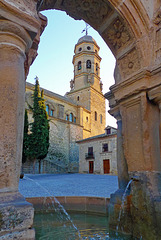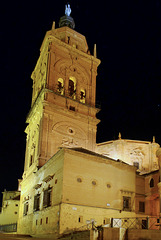
Andalucía - Andalusia
Spain - Sevilla, Real Alcázar
| |
|
|
|
The Real Alcázar de Sevilla (Royal Alcázar of Seville): details of the sumptuous decorations.
Spain - Sevilla, Real Alcázar
| |
|
|
|
The Real Alcázar de Sevilla (Royal Alcázar of Seville) was originally a Moorish fort. The palace is renowned as one of the most beautiful in Spain and is the oldest royal palace still in use in Europe, being used by King Juan Carlos when he visits Seville. The Real Alcazár was declared a World Heritage Site by UNESCO in 1987.
The Real Alcázar is built on the site of a Roman fort. The first Caliph of Andalusia ordered in the 10th century the construction of a castle, which later changed into a fortified palace. When Ferdinand III of Castile regained the city on the Moors in 1248, the Alcazar became the royal palace. Most of the present buildings were constructed after 1364, when King Pedro the Cruel commissioned the construction of a new palace
The numerous rooms, patios and halls vary in architectural styles in the mudejar style, but it has also islamic, gothic, renaissance, baroque and neoclassical elements.
Picture(s): the Patio de las Doncellas (Patio of the Maidens) is the main courtyard of the palace. This was the center of public life in the palace. The patio is named after the ladies (doncellas) who spent much of their time here.
Spain - Andalusia, Montoro
| |
|
|
|
Montoro is a typical Andalusian ‘pueblo blanco’ (white village) which is perched on a bluff above the Rio Guadalquivir with its whitewashed houses. It is a quite historical town, with an Iberian, Greek, Roman and Moslem past. In the Roman era the town was called Epora. It became an important fortified town under the Moors; after changing hands between Moorish and Castilian kingdoms the town was finally conquered by King Fernando III and became its present name Montoro.
Montoro offers some fine historical sights (churches and city hall) around or nearby the central square Plaza de España. Another emblematic sight is the bridge over the Guadalquivir, connecting the old town with the neighbourhood of El Retamar. Its construction began in 1498 and took more than fifty years. The women of Montoro donated their jewelry and goods to raise money for the construction. That is why it is known as ‘Puente de las Donadas or Puente de las Donadas (Bridge of Donations or Damsels).
Spain - Córdoba, Medina Azahara
| |
|
|
|
Medina Azahara (in Arab: Madinat al-Zahra) was a city built in the year of 936 by Abd al-Rahman III and was named after the most beautiful and favorite woman from harem of the caliph. The city was the secular counterpart of the Mezquita in Córdoba.
Building material from Andalusia and North Africa was transported by 15.000 donkeys and 10.000 porters.
The city was built on three levels with a mosque, the home of the caliph and beautiful gardens. Halls and homes were embellished with alabaster, ivory, jasper and marble decorations.
The construction lasted forty years and during that time a complex of palaces, houses, kitchens, stables and bastions had been created. It had about 20.000 inhabitants, mostly military and court personnel with their families.
The city had just been completed when it was sacked by the Berbers in 1013 and razed to the ground.
In 1911 archaeologists started in Medina Azahara excavations. About one tenth of the walled city - with a total area of 112 hectares - is uncovered and partially reconstructed. They are still working on this place, which is considered being one of the most important medieval towns in Spain.
Main picture: an arche of ‘La Casa de la Alberca’ (House of the Pool)
PiP’s: some details of Medina Azahara
Spain - Córdoba, Puente Romano
| |
|
|
|
The ‘Puente Romano’ (Roman bridge) of Córdoba is a bridge in the centre of the city. It was built by the Romans in the early 1st century BC across the Guadalquivir river.
The bridge was built under the command of the Roman emperor Augustus, in 918 the Moors extended the bridge to the state in which it appears today: 247 meters long and around 9 meters wide. ‘Puente Romano’ has – after the Islamic reconstruction - 16 arcades, which is one less than the original one.
The present structure is a medieval reconstruction; in the year of 2006 the bridge was extensively restored.
The ‘Roman Bridge’ connects the Torre de Calahorra with the old city centre with the Mezquita Cathedral/Mosque.
Spain - Córdoba, Mezquita
| |
|
|
|
Decorations above one of the entrance gates - Puerta de la Concepción Antigua - of the Mezquita in Córdoba.
Spain - Córdoba, Mezquita
| |
|
|
|
Construction of the Great Mosque of Córdoba started in 798 by Abd al-Rahman I. The building is considered being the most beautiful expression of Islamic art in Spain. It was the place of worship for the rulers of the western Islamic empire Al-Andalus. The so called Mezquita is a jewel of Hispano-Islamic art with its 850 columns, double arches and Byzantine mosaics.
In the year of 1236 Córdoba was conquered by Fernando III and the mosque was consecrated as a cathedral. The cathedral canons ordered in 1523 the center of the mosque pulled down to make way for a gothic transept and apse, later embellished with renaissance decorations and in the mid-18th century baroque choir stalls and pulpits.
Spain - Córdoba, Mezquita
| |
|
|
|
The richly gilded ‘mihrab’ (prayer niche) is commonly considered being the juwel in the crown of the Mezquita. The mihrab - a horseshoe arch supported by two marble columns - is a masterpiece of architectural art, with geometric and flowing designs of plants and ornamented in stucco, gold leaf and tile.
The present mihrab came into being during the expansion of the mosque in the year of 961 !!
Traditionally the mihrab of a mosque faces in the direction of Mecca, which would be east-southeast, but the mihrab of the Mezquita in Córdoba unusually points south.
(during the expansion a number of domes with skylights over the area in front of the mihrab were built for extra light; didn’t make shooting perfect images easier for me)
Spain - Baños de la Encina, Castillo de Burgalimar
| |
|
|
|
The castle in Baños de la Encina has several names: Castillo de Burgalimar, Castillo de Baños de la Encina, Castillo de Bury Al-Hammam, which is derived from the Arabic Al-Hammam Bury, which means "castle of the baths”. The castle, located on a top of a hill above Baños de la Encina is the most important monument in the city.
The construction of Castillo de Burgalimar started in the year of 967 by Caliph Al-Hakam II, as described by a plaque next to the entrance. Originally it was a mighty military fortress in the foothills of the Sierra Morena. It was given over through a treaty by the Muslims to the Christians in 1225. After that it was used continually - by several different ‘owners’ - until the middle of the 17th century. The site was redundant until 1850 when it was used as the city cemetery. This practice continued until 1928; three years later the castle was declared a national monument.
The Bury Al-Hammam castle is one of the best preserved Moorish castles in Spain. The medium-sized stone building has an elliptical design and is surrounded by an impressive wall with fifteen towers and parapets.
The Baños de la Encina Castle is also known as the ‘fortress of the seven kings’, due to the number of monarchs who lived here, including Ferdinand the Catholic.
Spain - Úbeda, Capilla del Salvador
| |
|
|
|
Úbeda became more and more important during Moorish rule. The town was by Abd ar-Rahman II (822–852), who called it Medinat-Ubbadat Al-Arab (which means Úbeda of the Moors). The town was captured from the Moors in 1233 by King Fernado III.
Úbeda (and neighboring city of Baeza) benefited from extensive patronage in the early 16th century, resulting in the construction of a series of Renaissance style palaces and churches. In 2003, UNESCO declared the historic cores and monuments a World Heritage Site.
Although the ‘Sacra Capilla del Salvador del Mundo’ (Sacred Chapel of the Saviour)looks like a church, the building is a funerary monument and was created to be used as mausoleum of local nobility (nowadays there are religious services). Both interior and exterior are richly decorated; the main façade (picture) with relief work and statues. The building is considered to be one of the finest examples of Andalucian architecture from te Renaisance period.
Construction of the chapel started in 1536 by the architect Diego de Siloé; a second phase, four years later, was directed by Andrés de Vandelvira. In 1559 it was consecrated.
Spain - Baeza, Plaza del Pópulo
| |
|
|
|
The Plaza del Pópulo is the most beautiful square of Baeza; it is also known as Plaza de los Leones , referring to the fountain of the same name. The square is surrounded by impressive buildings dating back to the heyday of Baeza. The name Plaza de Pópulo refers to the Virgen del Pópulo, the patron saint of the city .
La Antigua Carnicería dates from the 16th century. This old butchers shop (Antigua Carniceria) stood about 100 metres from its present spot and was moved stone by stone to the Plaza de los Leones. The façade on the upper floor shows the coat of arms of Emperor Carlos V, a double-headed eagle.
The building has been used as municipal slaughter house until late in the20th century, but nowadays houses a court of law.
Fuente de los Leones is an archaeological monument that once stood in the Roman city of Cástulo .
The Fountain of the Lions is a symbol of Baeza, expressing the pride of the city after being chosen as heir of Cástulo with the same features, such as capital and seat of a bishopric.
Spain - Baeza, Palacio de Jabalquinto
| |
|
|
|
Palacio de Jabalquinto (Jabalquinto Palace) is a late 15th century palace and is considered te be one of the landmarks of Baeza. This former palace of Juan Alfonso de Benavides is a fine example of flamboyant Spanish Renaissance Gothic with Mudéjar influences.
The beautiful façade with Moorish influences is the work of Juan Guas and Enrique Egas and illustrates the fondness of the former nobility for ornate decorations with pineapples, flower shapes, garlands and decorative turrets. The two columns with the balconies are conspicuous.
Palacio de Jabalquinto has a courtyard in Renaissance style with a monumental baroque staircase.
Nowadays the building belongs to the International University of Andalusia "Antonio Machado".
Spain - Baeza, Cathedral
| |
|
|
|
The Cathedral of Baeza (Catedral de Baeza) is a Roman Catholic cathedral. It is built on a Roman temple, which later became a mosque and was converted to Christianity in 1147. In the period between 1570 and 1593 several renaissance elements were added to the cathedral and the building became its present look. Nowadays it forms part of the UNESCO World Heritage Site with other monuments in Baeza.
Spain - Baeza, Plaza de Santa María
| |
|
|
|
The origins of Baeza date back to the first settlers during the Bronze Age, when it was a significant settlement from the Algar culture. In the Roman period a completely established town was built, including a castle and city walls. The Moors settled here and Baeza even was the capital of one of the Moorish Tarifa kingdoms.
The city became its greatest splendour during the 15th and 17th century, when its economy prospered thanks to its agriculture and the impetus of the University of Baeza.
Baeza is known as the cradle of Spanish renaissance. The UNESCO named the city a World Heritage Site in 2003.
Baeza still has a lot of important monumental complexes. The Plaza de Santa María can be considered as the heart of the city, offering most of the monuments; among them the cathedral ‘Santa Iglesia Catedral’and ‘Fuente de Santa María’.
Spain - Andalusia, River Gor Valley
| |
|
|
|
The main attraction of the valley and its capital Gorafe are the almost 200 Neolithic dolmens scattered in several cemeteries around the village. It is the greatest concentration of prehistoric rests in Spain. The first human settlements date back to prehistory.
The picture shows a view from the ‘Parque Megalítico’ into the canyon of the river Gor just south of Gorafe; on the background the high mountains of the Sierra Nevada.
Spain - Guadix, Cathedral
| |
|
|
|
The Cathedral of Guadix (Catedral de la Encarnación de Guadix) is a Roman Catholic cathedral. The baroque style building was under construction for a long period; it began in the 16th century and was completed in the mid-18th century.
Guadix is believed to be one of the oldest diocesan seats in Spain. The cathedral stands on the site of an earlier Visigoth church extant in the 10th century, upon which - during the period of Muslim domination - a mosque was built. Guadix was captured by the Christian forces in 1489 and the Visigoth church was reestablished as the official seat of a bishop. It was given the name of the “Church of Saint Mary of the Incarnation” (Iglesia de Santa María de la Encarnación) and later was made a cathedral by a bull of Pope Innocent VIII.
Andalusia - La Calahorra Castle
| |
|
|
|
The ‘Calahorra Castle’ (Castillo de La Calahorra) is located on the top of a hill above to the village La Calahorra and the plateau of the Marquesado in the northern foothills of the Sierra Nevada. The first fortification at this site was an imposing medieval fortress of Moorish origin. In 1490 the ‘Catholic Monarchs’ gave the fortress to Cardinal Pedro González de Mendoza in reward for his important role in the Christian conquest of Granada.
Don Rodrigo, an illegitimate son of the cardinal, inherited La Calahorra Castle in the year of 1495.
This first Marquis of Zenete travelled a lot to Italy and loved the Italian architecture. La Cahorra Castle became the first Italian renaissance castles outside Italy and the first in Andalusia displaying these architectural features. The castle was rebuilt between 1509 and 1512 on the site of the former Moorish fortification.
Nowadays the castle can be visited, although its opening hours are quite limited.
Spain - Andalusia, La Peza
| |
|
|
|
La Peza is a small Andalusian village located on the slope of Monte Rosado and in front of the Sierra Nevada
La Peza was an old Roman castro, whose name comes from the word lápice (stone).
In the times of the Roman domination it receives the name of Roman Castrum and this time is the one that dates the origin of this town.
Jump to top
RSS feed- Latest items - Subscribe to the latest items added to this album
- ipernity © 2007-2024
- Help & Contact
|
Club news
|
About ipernity
|
History |
ipernity Club & Prices |
Guide of good conduct
Donate | Group guidelines | Privacy policy | Terms of use | Statutes | In memoria -
Facebook
Twitter

